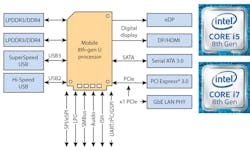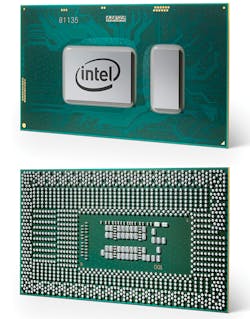Intel’s new 14-nm, Mobile U series of Core processors (Fig. 1) uses only 15 W and supposedly provides a 40% performance boost compared to the prior 7th-generation system. The chips can deliver 4K Ultra HD video and incorporate VP9 and HEVC 10-bit hardware acceleration. All of these new features create a faster, more power-efficient chip—but like any specifications, the devil is in the details.
The comparison between the Gen 8 Core i7-8850U and Gen 7 Core i7-7500U platform involved SYSmark 2014 SE. The trick is that the Gen 8 Core i7-8850U is a four-core/eight-thread device with a 4-GHz Turboboost, while the other is a two-core/four-thread device with a 3.5-GHz Turboboost.
1. Intel’s latest generation of mobile Core processors includes Thunderbolt 3 support in addition to USB 3 and Gigabit Ethernet.
Though the comparison is actually valid from a price and family perspective, there isn’t a marked difference in single-core performance. More cores provide better overall performance; even a single-thread application benefits from more cores that can run the operation system and other applications simultaneously. Applications like games now take advantage of multicore platforms.
With that detail is out of the way, let’s take a closer look at the family.
The Gen 8 Mobile U family includes Core i5 and Core i7 processors at this point (Fig. 2). They include USB3 and USB2 support as well as Thunderbolt 3. The latter provides a 40-Gb/s transfer rate capable of driving up to a pair of Ultra HD displays. Combined with a Type-C connection, it can provide up to 100 W of power. It’s one option for linking to a docking station.
2. Currently, the Gen 8 Mobile U family features Core i5 and i7 processors.
The extended battery life is due to a combination of better core performance and management along with more power-efficient 4K video playback hardware. As a result, full-length movies can be viewed on a battery-powered system, since the main processor is usually sleeping while the playback hardware does the heavy lifting of the streaming video. We are now up to ACPI 5.0, and the built-in Collaborative Processor Performance Control (CPPC) helps manage the new deep, low-power states.
The chip supports PCI Express Gen 3, including NVMe with a x4 PCI Express connection. The system can provide RAID 0, 1, 5, and 10 support with sufficient drives. Security features include BIOS Guard and Boot Guard, which require authentication for updates and provide secure boot support. The operating system can also disable USB and SATA ports to prevent malicious applications from being loaded via USB flash drives.
This latest crop of chips should make designers happy, since they deliver an overall performance boost while using less power. The differences between this new family and the prior generation aren’t as dramatic depending on the application, but in general, the new features like Thunderbolt 3 support make the Gen 8 solution more valuable.




